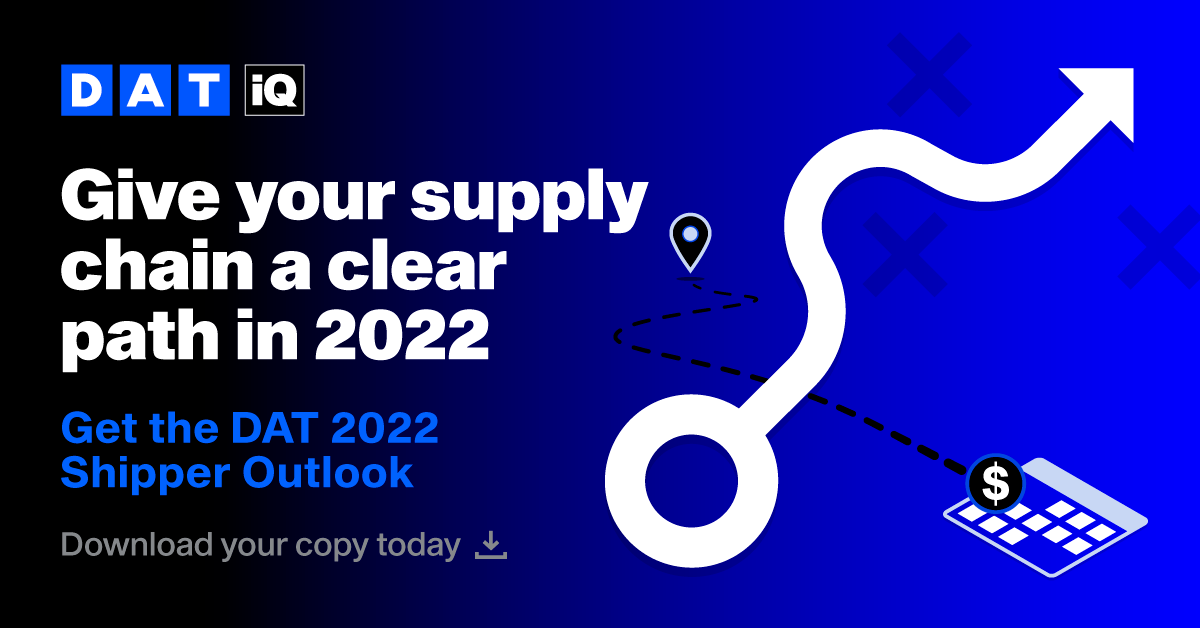Supply chain upheavals made transportation spend management extremely difficult in 2021. Those conditions are likely to stabilize at some point in 2022, but expect a volatile market to continue until then – maybe longer – because the factors that affect spot rates and freight volumes aren’t going away anytime soon.
They include:
- Constraints on new truck builds
- Depleted used truck inventory
- Severe driver shortage
- Growing freight demand
- Continued supply chain disruption
Some corporate executives are saying they expect supply chain problems will last through 2023, but shippers that use data intelligence can insulate themselves from transportation management woes and reduce logistics costs.
Let’s look at broader market trends affecting transportation spend management in the months ahead and identify ways you can prepare for the New Year.
A transportation market correction is coming, but disruption still looms
Assuming supply chain backlogs and equipment imbalances dissipate following the peak season, a transportation market correction is likely coming in 2022. When it does, shippers can expect transportation pricing to return to a normal rate of inflation rather than a steep pullback.
Until then, inventory replenishment through Q4 will be an ongoing effort and create a ripple-down effect for many shippers. For some, delivery delays will result in a surplus of untimely or misplaced products. Others will grapple with a returns process that echoes the historic spike in e-commerce since COVID-19 emerged. Capacity constraints will continue.
The past two years have taught logistics managers to expect that some level of disruption will always impact their plans. Even without global disruptions you can expect tender rejections, routing guide leakage and spot market premiums to continue jeopardizing your ability to control and reduce transportation costs.
To plan for market corrections – or new disruptions – and develop response strategies, you need to know which areas of your network are the most susceptible to transportation spend management risks.
Expect logistics cost pressures to persist
Truckload rates at record highs triggered an unprecedented number of new entrants in the carrier marketplace. Anticipated cost increases in 2022 will hit new carrier operations the hardest, especially as inflationary pressure drives up truck and trailer prices.
For example:
- The price of a used 2016 model year truck rose more than 128% over the past year.
- In the first nine months of 2021, new tractors sold at prices 87% higher, year-over-year.
- On average, buyers spent $15,000 more on tractors.
Two more looming carrier cost drivers in 2022, according to an analysis on trucking expenses by American Transportation Research Institute (ATRI), are driver compensation and diesel fuel prices.
Meanwhile, brokers are paying more for capacity as they solve difficult challenges during high demand. At times in 2021, as much as 25% of total truckload freight moved on the spot market. Pre-pandemic, 13% of shipments were spot moves.
That uptick adds production costs for brokers on top of increased transportation rates, so operating margins are shrinking while volume grows.
As increased market demand continues to stretch capacity thin into 2022, expect higher quotes for short-term contracts and higher premiums in the spot market. Knowing the current rates in this environment can help you improve your negotiating position and your ability to control transportation costs.
Transportation analytics enable better spend management
When 2022 brings unplanned freight volumes, network disruptions or difficult conversations about transportation costs, effective spend management will depend on in-depth and accurate insights on rates, carrier performance and market forecasts.
Intelligence-based carrier sourcing solutions help you access a complete picture of transportation providers who have capacity to service lanes where you need additional volume.
Freight rate analytics with broad, deep data sets and rate lookups for single or multiple lanes can help you evaluate mini-bids and quotes from carriers in the spot market. These current market rate insights ensure you get fair prices in every demand environment.
At the same time, rate forecasts on key lanes – both daily for the coming week and weekly for the coming year – empower you to pinpoint the biggest expected increases. This might highlight a need for alternative plans or a review of your current contract rates to make sure they stay in alignment.
To further support strategic planning, granular benchmarks on network performance identify where your carrier- and lane-level costs surpassed market averages last year, so you can more closely monitor and plan for those costs in 2022.
Combined, these solutions allow you to navigate logistics challenges while improving transportation spend management in the year ahead.
To learn more about how DAT Freight & Analytics can help you finish the year strong and build momentum into 2022, check out the DAT 2022 Shipper Outlook.


